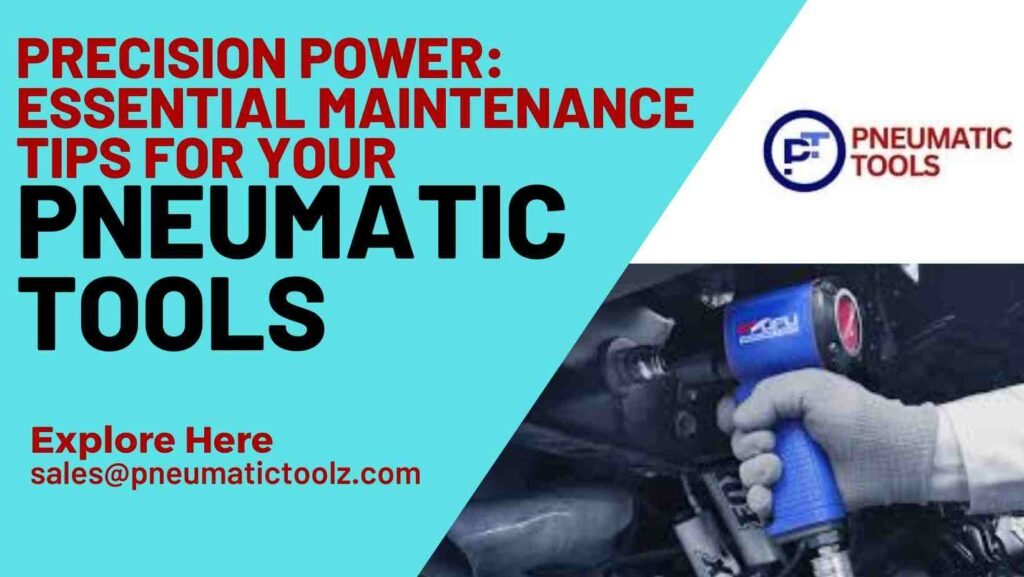Pneumatic tools are essential components in many industries, and they are known for their reliability and power. However, a dedicated maintenance routine is crucial to maintain them at peak performance. This guide offers detailed advice on caring for your pneumatic tools, ensuring they remain dependable and efficient.
Key Takeaways
- Consistent cleaning and lubrication are crucial.
- Regular inspections are necessary to catch and address issues early.
- Proper storage will protect and extend the life of your tools.
Understanding Pneumatic Tool Maintenance
Regular Cleaning and Moisture Protection
Pneumatic tools require frequent cleaning to prevent buildup that can impair their function. After use, remove any debris or dirt with a clean cloth, and periodically use compressed air to blow out particles from internal components. Regular cleaning also helps to eliminate moisture. Moisture can be particularly detrimental to pneumatic tools, affecting the air pressure sensitivity and causing rust or degradation. Use dryers or moisture separators to keep the air supply dry, especially in humid conditions.
Leak Checks:
Check for leaks regularly using soapy water or specialized leak detection solutions. Even small leaks can significantly impact the tool’s efficiency and the compressor’s workload.
Using a Filter/Regulator:
To ensure your pneumatic tools operate at peak efficiency, installing a filter/regulator is crucial. This device not only cleans the air to remove impurities that could damage the tool but also regulates the pressure to an optimal level, preventing overpressure that can lead to rapid wear and tear.
Replacing Worn Parts:
Preventative maintenance, such as replacing worn or aging parts, can prevent unexpected breakdowns. Monitor the components that undergo the most wear and have replacements ready to avoid downtime.
Lubrication Is Key
Lubricating the moving parts of your pneumatic tools regularly is vital to prevent wear and tear. Check the manufacturer’s manual for specific recommendations on lubrication types and schedules to keep your tools running smoothly. Proper lubrication reduces friction between moving parts, minimizes wear, and extends the tool’s lifespan. Follow the manufacturer’s guidelines on lubrication intervals and types of lubricant best suited for your specific tools.
Conduct Routine Inspections
Inspect your tools regularly for any damage or wear, such as cracked housings or worn seals. Replace any faulty parts immediately to maintain optimal performance and safety.
Air Supply System Maintenance
Maintaining the air system is equally essential for tools powered by an air compressor. Ensure hoses are intact and free from leaks and that the compressor delivers consistent pressure as specified for your tools.
Deep Dive: Caring for Your Pneumatic Tools
Battery Management for Cordless Models
If you use cordless pneumatic tools, managing the battery life is critical. Charge the batteries per the manufacturer’s guidelines and store them in a cool, dry place to maximize lifespan.
Usage Within Limits
Only push your pneumatic tools within their design specifications. Using tools for applications that exceed their rated capacity can lead to breakdowns and reduce their lifespan.
Proper Storage Solutions
Store your tools in a clean, moisture-free environment. Keep them in a padded case to protect against physical damage and environmental factors.
Choosing the Right Air Compressor:
Consider the type of air compressor you use. While reciprocating air compressors are common and build up pressure quickly, they might not sustain it as effectively as rotary screw compressors, which are better for applications requiring steady, high-pressure air.
Blade Maintenance:
Sharp blades are essential for tools with cutting components. Dull blades compromise the quality of your work and can strain the tool. To maintain performance and protect your material, regularly sharpen the blades and replace them when they are beyond sharpening.
Implementing a Maintenance Schedule
Adherence to a regular maintenance schedule ensures that all aspects of your pneumatic tools are checked and maintained. Depending on usage frequency, monthly or quarterly checks may be required. Maintain a log of maintenance activities to track the condition of your tools over time.
Conclusion
Regular maintenance of your pneumatic tools isn’t just about upkeep; it’s essential for ensuring safety and efficiency in operations. By following these tips, your tools will perform better, last longer, and continue to be a vital part of your work.
FAQs
- How often should I lubricate my pneumatic tools?
- Generally, after every 20 hours of use or more frequently in dusty conditions.
- What type of oil should I use for my pneumatic tools?
- Use air tool oil designed explicitly for pneumatic equipment to prevent deposits.
- Can I perform maintenance on my pneumatic tools myself?
- Essential maintenance like cleaning and lubrication can be done yourself, but for internal repairs, consult a professional.
- What are the signs that my pneumatic tools need maintenance?
- Decreased performance, unusual sounds, or excessive vibration can indicate maintenance needs.
- Why is air hose maintenance essential for pneumatic tools?
- A well-maintained air hose ensures optimal airflow and pressure, which is critical for tool performance.
Ensure your projects always meet the mark with high-quality pneumatic tools from PneumaticToolz.com. Discover our range of tools and accessories designed to deliver precision and power when needed. Visit us today to enhance your tool collection with the best pneumatic technology.
Related Articles
Easy Maintenance of Pneumatic Tools: Keeping Your Air Tools in …
Deep Dive: Caring for Your Pneumatic Tools
Air Tool Maintenance: Ensuring Efficiency and Longevity
Pneumatic tools maintenance: How often should you Lubricate your …
Pneumatic tools maintenance: How Important is it to lubricate air tools?



